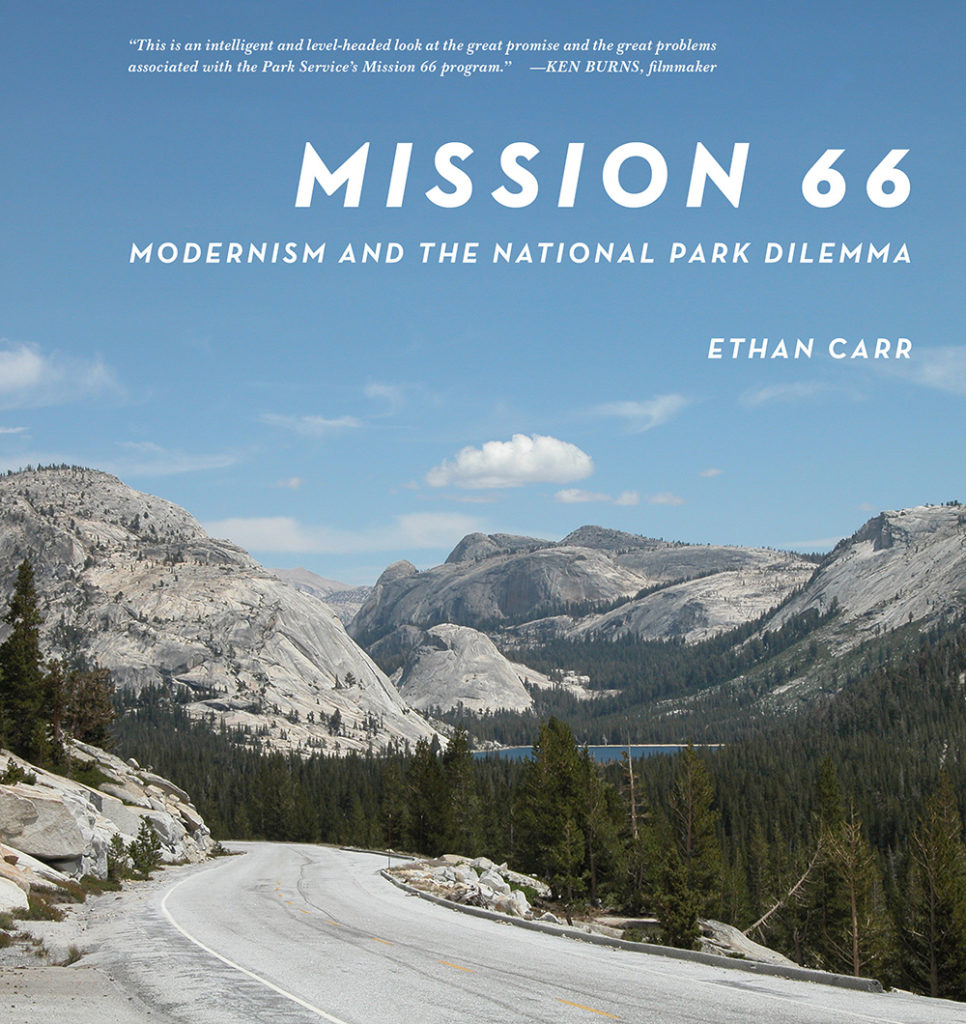Mission 66
Modernism and the National Park Dilemma
Ethan Carr
Library of American Landscape History
| ISBN: 978-1-952620-33-1 | 424 pages | 9.625 x 10 inches |
| 40.00 | Paper | Published: 02/17/2022 |
| 225 b&w photos and drawings | |
A volume in the series Designing the American Park
In the years following World War II, Americans visited the national parks in unprecedented numbers, yet Congress held funding at prewar levels and park conditions steadily declined. Elimination of the Civilian Conservation Corps and other New Deal programs further reduced the ability of the federal government to keep pace with the wear and tear on park facilities.
To address the problem, in 1956 a ten-year, billion-dollar initiative titled “Mission 66” was launched, timed to be completed in 1966, the fiftieth anniversary of the National Park Service. The program covered more than one hundred visitor centers (a building type invented by Mission 66 planners), expanded campgrounds, innumerable comfort stations and other public facilities, new and wider roads, parking lots, maintenance buildings, and hundreds of employee residences. During this transformation, the park system also acquired new seashores, recreation areas, and historical parks, agency uniforms were modernized, and the arrowhead logo became a ubiquitous symbol. To a significant degree, the national park system and the National Park Service as we know them today are products of the Mission 66 era.
Mission 66 was controversial at the time, and it continues to incite debate over the policies it represented. Hastening the advent of the modern environmental movement, it transformed the Sierra Club from a regional mountaineering club into a national advocacy organization. But Mission 66 was also the last system-wide, planned development campaign to accommodate increased numbers of automotive tourists. Whatever our judgment of Mission 66, we still use the roads, visitor centers, and other facilities the program built.
Ethan Carr’s book examines the significance of the Mission 66 program and explores the influence of midcentury modernism on landscape design and park planning. Environmental and park historians, architectural and landscape historians, and all who care about our national parks will enjoy this copiously illustrated history of a critical period in the development of the national park system.
"This is an intelligent and level-headed look at the great promise and the great problems associated with the Park Service's Mission 66 program. Embedded in it—and in this fascinating book as well—is the age-old dilemma that has plagued our National Parks since their inception, namely, how to make them accessible to everyone while at the same time saving them from those who too often end up 'loving them to death.'"
“This book deserves high praise and wide circulation because of its intellectual scope and analytical, as well as documentary, content. Ethan Carr’s framing of the subject within the wilderness vs. recreation dialectic makes the book valuable beyond the immediate subject. Mission 66 addresses an issue that is central to many of us today and one that will continue to be vigorously debated well into the future.”
“Ethan Carr’s Mission 66 history . . . is among the finest studies of the National Park Service I’ve ever seen. . . . His concluding appraisal of Mission 66 is well reasoned and balanced.”
“As the National Park Service nears its 100th birthday, this unusually engaging book is a must-read for those who care about the past and future of the national parks.”
“Carr’s book sheds important light on how Mission 66 came about, how it was executed, how it fit (and sometimes didn’t) with the changing times of postwar America, and most important, how some of the underlying beliefs of the NPS leadership reflected an idea of national parks that can be traced back to its first expression with Frederick Law Olmsted a hundred years earlier.”
“A first-rate addition to the history of our national parks.”
2007 Elisabeth Blair MacDougall Book Award, Society of Architectural Historians
2007 Outstanding Academic Title, Choice
2008 J. B. Jackson Book Prize from the Foundation for Landscape Studies
About the Author
Ethan Carr
Ethan Carr, FASLA, is professor of landscape architecture at the University of Massachusetts Amherst and an international authority on America’s public landscapes. He is author of Wilderness by Design: Landscape Architecture and the National Park Service, Mission 66: Modernism and the National Park Dilemma, The Greatest Beach: A History of Cape Cod National Seashore, Boston’s Franklin Park: Olmsted, Recreation, and the Modern City, and coauthor of Olmsted and Yosemite: Civil War, Abolition, and the National Park Idea, lead editor of Public Nature: Scenery, History, and Park Design, and coeditor of Volume 8 of The Papers of Frederick Law Olmsted.
